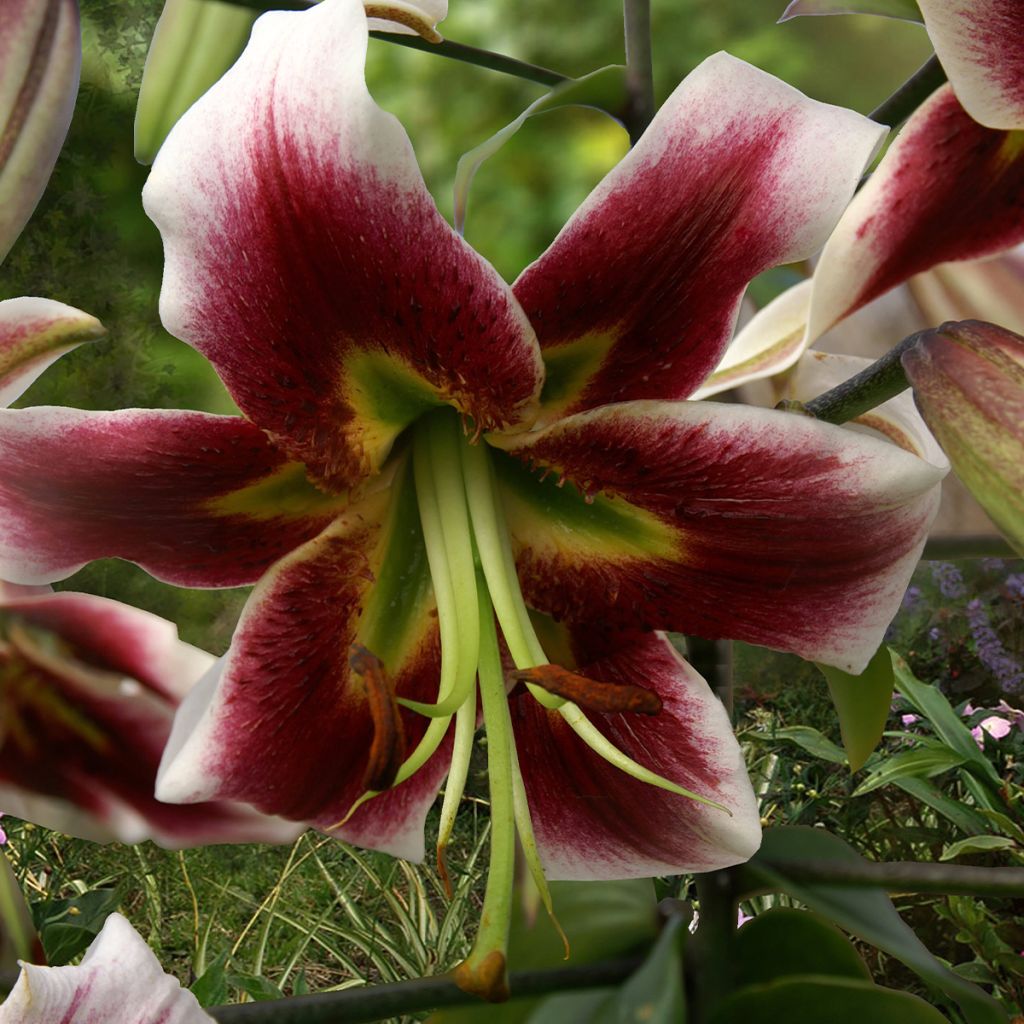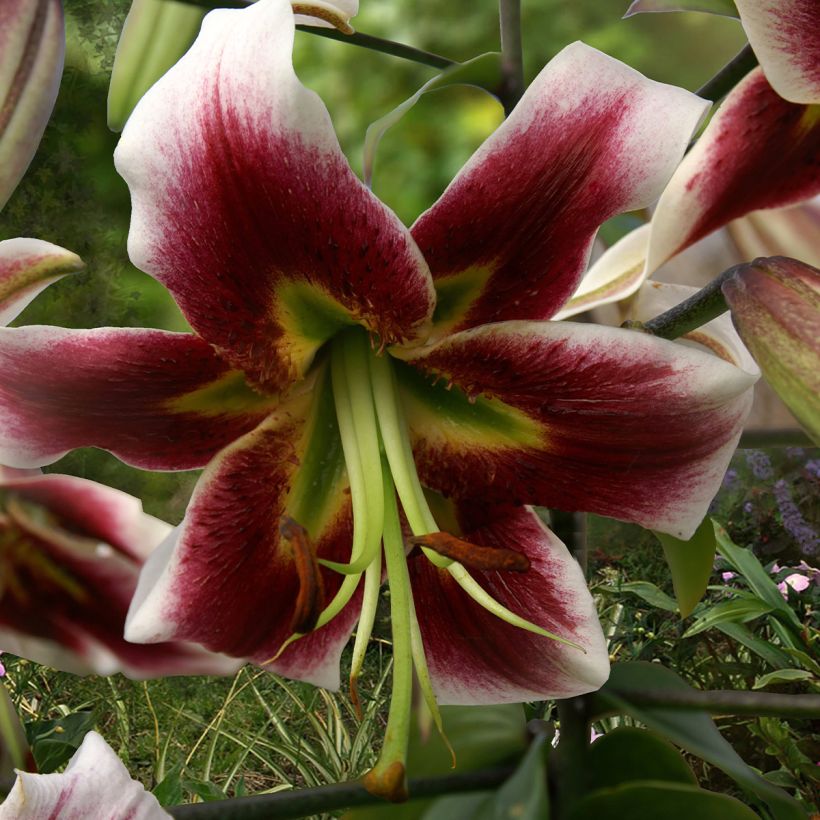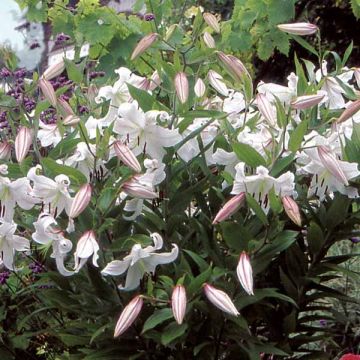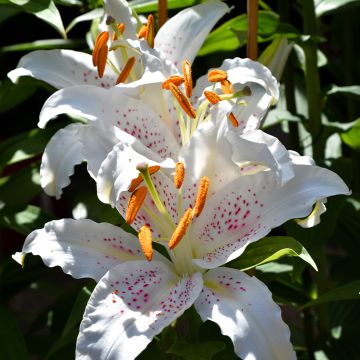

Lis hybride Leslie Woodriff - Lilium oriental / trompette


Lis hybride Leslie Woodriff


Lis hybride Leslie Woodriff - Lilium oriental / trompette
View more pictures
Hide images

Thierry P.

Flowering in June - image 2
Thierry P. • 84 FR
Lilium Leslie Woodriff - Oriental Lily
Lilium x orientale Leslie Woodriff
Oriental Lily
Thanks to the individuals (Julie for order preparation and ? from the shipping department), the received bulbs appear to be healthy. Now that they have been planted, I am patiently waiting for them to take root... or not?
Thierry, 02/02/2023
Special offer!
Receive a €20 voucher for any order over €90 (excluding delivery costs, credit notes, and plastic-free options)!
1- Add your favorite plants to your cart.
2- Once you have reached €90, confirm your order (you can even choose the delivery date!).
3- As soon as your order is shipped, you will receive an email containing your voucher code, valid for 3 months (90 days).
Your voucher is unique and can only be used once, for any order with a minimum value of €20, excluding delivery costs.
Can be combined with other current offers, non-divisible and non-refundable.
Why not try an alternative variety in stock?
View all →This plant carries a 6 months recovery warranty
More information
We guarantee the quality of our plants for a full growing cycle, and will replace at our expense any plant that fails to recover under normal climatic and planting conditions.
Would this plant suit my garden?
Set up your Plantfit profile →
Description
The Leslie Woodriff lily is an old and spectacular American variety which is still as popular as ever. It is one of the first hybrids obtained from crossing the oriental lily and the trumpet lily. The result of this cross-breeding is a very tall, floriferous plant, with immense, remarkably colourful and fragrant flowers. The flowers of 'Leslie Woodriff' are freshly multicoloured in deep cherry pink, white and yellow with a touch of green. In the summer of planting, the bulb will establish a good root system and produce around 5 flowers. But once mature, each bulb will produce a stem carrying up to 20 flowers.
Lilies belong to the Liliaceae family. There is a classification of horticultural lilies that includes 9 divisions, 'Leslie Woodriff' is classified in the Oriental x Trumpet hybrids group, called Orienpet. Hybridisers use the vigour and fragrance of lilies from the Trumpet group combined with the long stems and large flowers of the Orientals. Lilies in this category bloom in summer, between late June and September depending on the climate and the variety. The Leslie Woodriff lily forms a floral stem that is on average 1.70 m (6ft) tall, with mature plants reaching up to 2 m (7ft) in optimal conditions. At the top of the stem, flowers 20 to 30 cm (8 to 12in) in diameter fully open, slightly leaning towards the ground with slightly recurved petals. Each petal has a green basal spot bordered by yellow, a large cherry red area speckled with very dark red, and a border transitioning from pale yellow to white. In the centre, the long stamens are green and carry rust-coloured pollen. The deciduous vegetation disappears in winter and emerges from the ground in spring.
This is a very hardy plant that prefers humus-rich soil, the Leslie Woodriff lily is fairly tolerant, but it does not like excessively chalky, too dry or too heavy soils. You can plant your lilies in perennial and low shrub beds, as they appreciate shade at the base and the other plants will help prevent the stems from bending in the wind. The giant lily is ideal against a wall, for example with hollyhocks or tall delphiniums. It is also a beautiful companion for hydrangeas, roses, and hardy fuchsias. And its flowers are stunning in bouquets.
Lilium Leslie Woodriff - Oriental Lily in pictures


Plant habit
Flowering
Foliage
Botanical data
Lilium
x orientale
Leslie Woodriff
Liliaceae
Oriental Lily
Cultivar or hybrid
Other Hybrid Lilies
View all →Planting and care
Lilium Leslie Woodriff prefers humus-rich soil or compost. It does not tolerate soils that are too dry, heavy, or chalky. Good drainage is important, as it does not like waterlogged soils. You should plant it in full sun or partial shade, preferably in spring or October, burying the bulbs 15 cm (6in) deep in a mixture of soil and leaf compost. Surround them with a layer of sand to prevent rot and slug attacks, while allowing them to grow more easily. Mark the planting location, as the vegetation only starts in April. When the stems reach 30 cm (12in) tall, discreetly stake them.
If red lily beetles appear, treat them immediately as their larvae can devour all the leaves. The most effective method is to catch them manually but be careful as they drop as soon as they are touched. After flowering, it is a good idea to cut the faded flowers halfway to keep the bed beautiful during summer.
Your lilies will be available at the beginning of October. Plant them as soon as you receive them. This hybrid lily is also suitable for container gardening. Plant 1 to 5 bulbs in a deep pot. Water lightly and place your pots in a frost-free area. Bring them out in spring and enjoy their beauty on your terrace!
Planting period
Intended location
Care
Planting & care advice
-
, onOrder confirmed
Reply from on Promesse de fleurs
Similar products
Haven't found what you were looking for?
Hardiness is the lowest winter temperature a plant can endure without suffering serious damage or even dying. However, hardiness is affected by location (a sheltered area, such as a patio), protection (winter cover) and soil type (hardiness is improved by well-drained soil).

Photo Sharing Terms & Conditions
In order to encourage gardeners to interact and share their experiences, Promesse de fleurs offers various media enabling content to be uploaded onto its Site - in particular via the ‘Photo sharing’ module.
The User agrees to refrain from:
- Posting any content that is illegal, prejudicial, insulting, racist, inciteful to hatred, revisionist, contrary to public decency, that infringes on privacy or on the privacy rights of third parties, in particular the publicity rights of persons and goods, intellectual property rights, or the right to privacy.
- Submitting content on behalf of a third party;
- Impersonate the identity of a third party and/or publish any personal information about a third party;
In general, the User undertakes to refrain from any unethical behaviour.
All Content (in particular text, comments, files, images, photos, videos, creative works, etc.), which may be subject to property or intellectual property rights, image or other private rights, shall remain the property of the User, subject to the limited rights granted by the terms of the licence granted by Promesse de fleurs as stated below. Users are at liberty to publish or not to publish such Content on the Site, notably via the ‘Photo Sharing’ facility, and accept that this Content shall be made public and freely accessible, notably on the Internet.
Users further acknowledge, undertake to have ,and guarantee that they hold all necessary rights and permissions to publish such material on the Site, in particular with regard to the legislation in force pertaining to any privacy, property, intellectual property, image, or contractual rights, or rights of any other nature. By publishing such Content on the Site, Users acknowledge accepting full liability as publishers of the Content within the meaning of the law, and grant Promesse de fleurs, free of charge, an inclusive, worldwide licence for the said Content for the entire duration of its publication, including all reproduction, representation, up/downloading, displaying, performing, transmission, and storage rights.
Users also grant permission for their name to be linked to the Content and accept that this link may not always be made available.
By engaging in posting material, Users consent to their Content becoming automatically accessible on the Internet, in particular on other sites and/or blogs and/or web pages of the Promesse de fleurs site, including in particular social pages and the Promesse de fleurs catalogue.
Users may secure the removal of entrusted content free of charge by issuing a simple request via our contact form.
The flowering period indicated on our website applies to countries and regions located in USDA zone 8 (France, the United Kingdom, Ireland, the Netherlands, etc.)
It will vary according to where you live:
- In zones 9 to 10 (Italy, Spain, Greece, etc.), flowering will occur about 2 to 4 weeks earlier.
- In zones 6 to 7 (Germany, Poland, Slovenia, and lower mountainous regions), flowering will be delayed by 2 to 3 weeks.
- In zone 5 (Central Europe, Scandinavia), blooming will be delayed by 3 to 5 weeks.
In temperate climates, pruning of spring-flowering shrubs (forsythia, spireas, etc.) should be done just after flowering.
Pruning of summer-flowering shrubs (Indian Lilac, Perovskia, etc.) can be done in winter or spring.
In cold regions as well as with frost-sensitive plants, avoid pruning too early when severe frosts may still occur.
The planting period indicated on our website applies to countries and regions located in USDA zone 8 (France, United Kingdom, Ireland, Netherlands).
It will vary according to where you live:
- In Mediterranean zones (Marseille, Madrid, Milan, etc.), autumn and winter are the best planting periods.
- In continental zones (Strasbourg, Munich, Vienna, etc.), delay planting by 2 to 3 weeks in spring and bring it forward by 2 to 4 weeks in autumn.
- In mountainous regions (the Alps, Pyrenees, Carpathians, etc.), it is best to plant in late spring (May-June) or late summer (August-September).
The harvesting period indicated on our website applies to countries and regions in USDA zone 8 (France, England, Ireland, the Netherlands).
In colder areas (Scandinavia, Poland, Austria...) fruit and vegetable harvests are likely to be delayed by 3-4 weeks.
In warmer areas (Italy, Spain, Greece, etc.), harvesting will probably take place earlier, depending on weather conditions.
The sowing periods indicated on our website apply to countries and regions within USDA Zone 8 (France, UK, Ireland, Netherlands).
In colder areas (Scandinavia, Poland, Austria...), delay any outdoor sowing by 3-4 weeks, or sow under glass.
In warmer climes (Italy, Spain, Greece, etc.), bring outdoor sowing forward by a few weeks.





























































